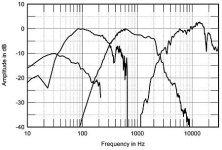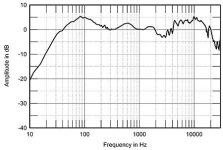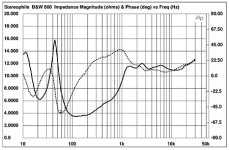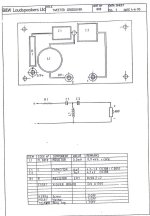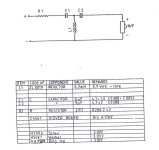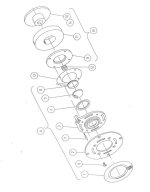Hi, everyone!
I am planning to replace the tweeters of my B&W Matrix 800 speakers.
I always felt that the speakers exhibit rather harsh treble particularly
with violin music. I have tried to resolve this by various measures such
as recapping and ferrofluid replacement. However, that didn't completely
resolve the harsh treble issue.
So I want to replace the tweeters with something more smooth
or more natural sounding. However, I don't have the technical
expertise to choose a right model. I know the model number
of the stock B&W Matrix 800 tweeter is ZZ05312 but I can't
find any technical details beyond that.
The only other thing I could do was to measure the DC resistances
of the original tweeters, which read 4.55Ohms and 4.75Ohms.
The specifications of B&W Matrix 800 is as follows:
- Impedance: 4Ohms nominal (3ohms minimum)
- Sensitivity: 93dB (for 2.83V at 1m)
- Recommended Power: 150W - 800W
- 3-Way speakers with two 12in polymer-cone woofer,
two 5in Kevlar-Cone midrange,
one 1.25in ferrofluid-cooled metal dome tweeter
- Frequency response 23Hz - 20kHz
Can anyone instruct me what specifications I have to consider
to determine the right tweeter?
Any of your comments and opinions will be appreciated.
For example,
- what nominal impedance should I choose? (6Ohm?, 8Ohm?)
- what sensitivity? (exact 93dB? or 94dB? or 95dB or higher?)
- what power handling?
- can I use any of the following?
Satori TW29TXN-B-8 [8Ohm, 6.2Ohm, 93.5dB], Satori TW29BN-B-8[8Ohm, DCR 6.2Ohm, 93.5dB],
ScanSpeak D2908/7140 [8Ohm, DCR 5.7Ohm, 92dB], Seas T29CF-002 [6Ohm, 4.7Ohm, 92.5dB],
Satori TW29BN-B [4Ohm, DCR 3.0Ohm, 95dB], and etc....
- any suggestions on possible model choices.
Thanks for reading,
< I attach some photos for your information >
I am planning to replace the tweeters of my B&W Matrix 800 speakers.
I always felt that the speakers exhibit rather harsh treble particularly
with violin music. I have tried to resolve this by various measures such
as recapping and ferrofluid replacement. However, that didn't completely
resolve the harsh treble issue.
So I want to replace the tweeters with something more smooth
or more natural sounding. However, I don't have the technical
expertise to choose a right model. I know the model number
of the stock B&W Matrix 800 tweeter is ZZ05312 but I can't
find any technical details beyond that.
The only other thing I could do was to measure the DC resistances
of the original tweeters, which read 4.55Ohms and 4.75Ohms.
The specifications of B&W Matrix 800 is as follows:
- Impedance: 4Ohms nominal (3ohms minimum)
- Sensitivity: 93dB (for 2.83V at 1m)
- Recommended Power: 150W - 800W
- 3-Way speakers with two 12in polymer-cone woofer,
two 5in Kevlar-Cone midrange,
one 1.25in ferrofluid-cooled metal dome tweeter
- Frequency response 23Hz - 20kHz
Can anyone instruct me what specifications I have to consider
to determine the right tweeter?
Any of your comments and opinions will be appreciated.
For example,
- what nominal impedance should I choose? (6Ohm?, 8Ohm?)
- what sensitivity? (exact 93dB? or 94dB? or 95dB or higher?)
- what power handling?
- can I use any of the following?
Satori TW29TXN-B-8 [8Ohm, 6.2Ohm, 93.5dB], Satori TW29BN-B-8[8Ohm, DCR 6.2Ohm, 93.5dB],
ScanSpeak D2908/7140 [8Ohm, DCR 5.7Ohm, 92dB], Seas T29CF-002 [6Ohm, 4.7Ohm, 92.5dB],
Satori TW29BN-B [4Ohm, DCR 3.0Ohm, 95dB], and etc....
- any suggestions on possible model choices.
Thanks for reading,
< I attach some photos for your information >
- FrequencyResponse(Drivers).jpg : Driver Frequency Response Measurement by Stereophile Magazine.
- FrequencyResponse(Overall).jpg : Overall Frequency Measurement by Stereophile Magazine.
- Impedance.jpg: Impedance Measurement by Stereophile Magazine.
- TweeterCrossOver.jpg : Tweeter Crossover contained in B&W Service Manual
Attachments
Are there any tweeters that fit the tweeter cutout?
Have you tried EQ to determine the frequency that is off?
Are you willing to buy a mic to measure?
Have you tried EQ to determine the frequency that is off?
Are you willing to buy a mic to measure?
Are there any tweeters that fit the tweeter cutout?
-> I can't find exact match. I think I will need some custom-made adapter ring.
Have you tried EQ to determine the frequency that is off?
-> No. I don't use EQ. By the way, if you see one of the attached frequency response measurement made by stereophile magazine, you will be able to see the frequency response. But, regardless of the loudness at a certain high frequency, the sound itself is not that pleasant.
Are you willing to buy a mic to measure?
-> Actually, I bought a mic for measurement but didn't yet use it.
-> I can't find exact match. I think I will need some custom-made adapter ring.
Have you tried EQ to determine the frequency that is off?
-> No. I don't use EQ. By the way, if you see one of the attached frequency response measurement made by stereophile magazine, you will be able to see the frequency response. But, regardless of the loudness at a certain high frequency, the sound itself is not that pleasant.
Are you willing to buy a mic to measure?
-> Actually, I bought a mic for measurement but didn't yet use it.
It can be a PITA to alter a tweeter cutout. I suspect that you might try several to see which has the sound you like. I read the review of the speaker. They say it's picky about source equipment, etc. I don't spend big bucks on drivers, but I have a few I like a lot. What I would suggest is measuring just the tweeter. That will give you a reference point to match. If you can measure the cutout for the tweeter, it may be somewhat common. For example, there's a few tweeters that are 104mm overall diameter. Sometimes there's notches in the hole for the wiring / leads. These are not too hard to alter, but if you can find a tweeter that drops in, that would be a good start. I like Morel tweeters, but there's many I have not heard.
There are x-over tweaks that could help. A notch filter is like EQ, but better. It can be tuned to specific frequencies. You could run wires out to try several frequencies with the parts outside the box. Measuring would confirm what you are changing. It might be as small as a 2dB change to get a better sound. Just looking at the response, I'd probably add a notch at 10k. The parts to do this are less expensive than a good tweeter. Everything above 4k could be brought closer to the 0dB line. It would be a gradual notch.
There are x-over tweaks that could help. A notch filter is like EQ, but better. It can be tuned to specific frequencies. You could run wires out to try several frequencies with the parts outside the box. Measuring would confirm what you are changing. It might be as small as a 2dB change to get a better sound. Just looking at the response, I'd probably add a notch at 10k. The parts to do this are less expensive than a good tweeter. Everything above 4k could be brought closer to the 0dB line. It would be a gradual notch.
Last edited:
Dear temp25,
Thanks for your suggestions.
First of all, regarding your suggestion for notch filter,
I will try. If you watch the first two attached photos,
you will notice that the gain is low between 2-4kHz
and high between 5-10kHz. I am not sure if I can
increase the gain between 2-4kHz considering
the tweeter and the midrange response shown
in the first photo. In any case, I will try some
further crossover tweak according to your suggestion.
Secondly, the cutout diameter is about 97cm (the cutout
is not exactly circular because of the path for wires).
The tweeter plate has diameter 125mm with 4 screw holes
with diameter 113.14mm. I think the size of the plate is not
that typical. As you pointed out, there are some tweeters
with overall diameter 104mm. I think I can find some local
wood-working shop to cut wood to make an appropriate
adaptor ring for such tweeters or I might use some 3D
printing services.
So fitting tweeters into the cutout is something I have to
deal with later. The first thing is to know what tweeter
specifications I have to look for.
First of all, I need to know what impedance I have to choose
for the tweeter. Should I choose 4ohm, 6ohm, or 8ohm?
Secondly, what sensitivity should I choose? Should it be 93dB
because Matrix 800 is 93dB speaker? Or should it be higher than
93dB? For example, if I buy 92dB tweeter and if the gain is too
low, there is no way to compensate the gain by tweaking crossover.
So I want to know how high the sensitivity of the tweeter should be.
I just don't know where to start in selecting the tweeters.
That's my problem.
Thanks for your suggestions.
First of all, regarding your suggestion for notch filter,
I will try. If you watch the first two attached photos,
you will notice that the gain is low between 2-4kHz
and high between 5-10kHz. I am not sure if I can
increase the gain between 2-4kHz considering
the tweeter and the midrange response shown
in the first photo. In any case, I will try some
further crossover tweak according to your suggestion.
Secondly, the cutout diameter is about 97cm (the cutout
is not exactly circular because of the path for wires).
The tweeter plate has diameter 125mm with 4 screw holes
with diameter 113.14mm. I think the size of the plate is not
that typical. As you pointed out, there are some tweeters
with overall diameter 104mm. I think I can find some local
wood-working shop to cut wood to make an appropriate
adaptor ring for such tweeters or I might use some 3D
printing services.
So fitting tweeters into the cutout is something I have to
deal with later. The first thing is to know what tweeter
specifications I have to look for.
First of all, I need to know what impedance I have to choose
for the tweeter. Should I choose 4ohm, 6ohm, or 8ohm?
Secondly, what sensitivity should I choose? Should it be 93dB
because Matrix 800 is 93dB speaker? Or should it be higher than
93dB? For example, if I buy 92dB tweeter and if the gain is too
low, there is no way to compensate the gain by tweaking crossover.
So I want to know how high the sensitivity of the tweeter should be.
I just don't know where to start in selecting the tweeters.
That's my problem.
You could mount a new tweeter on the existing faceplate but it's a lottery to find one that is suitable. Even then it would require crossover changes. Best to try some changes in the crossover and could be as simple as increasing the padding, or add a 15R-22R resistor parallel to the tweeter, or a parallel CR to tilt down the top octave. As a test you could try the Yamaha NS-10M trick by placing a tissue over the tweeter to reduce the treble edge.
Don't get hung up on the published FR as can be misleading. Lifting the 2-4kHz dip could make the speaker sound more harsh and introduce fatigue. A lot of speakers have this dip and it's there for a reason to make it more pleasant for the ears.
Check to see if the harshness is coming from the tweeter by disconnecting it as a lot of times it comes from the mid driver.
Don't get hung up on the published FR as can be misleading. Lifting the 2-4kHz dip could make the speaker sound more harsh and introduce fatigue. A lot of speakers have this dip and it's there for a reason to make it more pleasant for the ears.
Check to see if the harshness is coming from the tweeter by disconnecting it as a lot of times it comes from the mid driver.
Attachments
I think first of all you should check the condition of the original tweeters. Are they still 100 percent or might the ferrofluid have dried up? Measurements will tell, both impedance and level.
Probably not.Don't get hung up on the published FR as can be misleading. Lifting the 2-4kHz dip could make the speaker sound more harsh and introduce fatigue. A lot of speakers have this dip and it's there for a reason to make it more pleasant for the ears.
It is otherwise known as a phase issue and the crossover needs to be 1400 Hz not 3000 Hz.
Excluding using truncated mids, then still manage to mount the tweeter far away. With larger center to center spacing than needed.
Excluding 2x mids at 5 inches will behave like 10" vertical like many magical "MTM's"
looking at the midrange response the crossover coil values probably rather poor for the actual impedance.
And with such poor Q and no impedance correction, The peaking response of all the drivers is very visible.
would expect to carry forward for the tweeter as well.
It does, excluding the 3 almost 4 dB response peak and huge dip up higher, AKA lots of cone breakup even at 1 watt.
At this point even Dayton RST28F or RST28A would beat it by a landslide.
With big rear chambers and Fs down in the 700 ish range they can actually cross over at 1400 Hz
Needs a little crossover work for sure, a custom plate be easy to make if needed, since the mounting plates can be changed.
It hurts a bit to read that you would mechanically alter the tweeter section of these magnificent speakers. These tweeters do reproduce what's been given to them. I know exactly what you are talking about, I do own a pair of 800's. Listen with sloppy produced pop/rock music and you will hear all the flaws. Take some well treated pop/rock, jazz or classical music, good amplifiers and they will shine. If you are looking for tweeters that will mask the recording and mastering flaws, you will also loose the richness of well treated recordings.
Now tell us if you hear that harshness with a good classical production or some brilliant ECM recordings as examples. I don't. 🙂
Now tell us if you hear that harshness with a good classical production or some brilliant ECM recordings as examples. I don't. 🙂
I'd start with a measurement, or two. What mic do you have? Have you ever used REW software?Are there any tweeters that fit the tweeter cutout?
-> I can't find exact match. I think I will need some custom-made adapter ring.
Have you tried EQ to determine the frequency that is off?
-> No. I don't use EQ. By the way, if you see one of the attached frequency response measurement made by stereophile magazine, you will be able to see the frequency response. But, regardless of the loudness at a certain high frequency, the sound itself is not that pleasant.
Are you willing to buy a mic to measure?
-> Actually, I bought a mic for measurement but didn't yet use it.
By coincidence, I was just looking at this tweeter. It has a very large flange, and might be an option you could try. It's slightly low on sensitivity, but the 800 has a 2.7 ohm padding resistor, so I think this could work. Plus, you're trying to tame the top end anyway. Sometimes speaker sensitivity ratings are misleading anyway. Hope you can measure what you have.Dear temp25,
Thanks for your suggestions.
First of all, regarding your suggestion for notch filter,
I will try. If you watch the first two attached photos,
you will notice that the gain is low between 2-4kHz
and high between 5-10kHz. I am not sure if I can
increase the gain between 2-4kHz considering
the tweeter and the midrange response shown
in the first photo. In any case, I will try some
further crossover tweak according to your suggestion.
Secondly, the cutout diameter is about 97cm (the cutout
is not exactly circular because of the path for wires).
The tweeter plate has diameter 125mm with 4 screw holes
with diameter 113.14mm. I think the size of the plate is not
that typical. As you pointed out, there are some tweeters
with overall diameter 104mm. I think I can find some local
wood-working shop to cut wood to make an appropriate
adaptor ring for such tweeters or I might use some 3D
printing services.
So fitting tweeters into the cutout is something I have to
deal with later. The first thing is to know what tweeter
specifications I have to look for.
First of all, I need to know what impedance I have to choose
for the tweeter. Should I choose 4ohm, 6ohm, or 8ohm?
Secondly, what sensitivity should I choose? Should it be 93dB
because Matrix 800 is 93dB speaker? Or should it be higher than
93dB? For example, if I buy 92dB tweeter and if the gain is too
low, there is no way to compensate the gain by tweaking crossover.
So I want to know how high the sensitivity of the tweeter should be.
I just don't know where to start in selecting the tweeters.
That's my problem.
https://www.parts-express.com/pedocs/specs/264-1676--peerless-da25tx00-08-spec-sheet.pdf
https://www.parts-express.com/Peerless-DA25TX00-08-1-Corundum-Dome-Tweeter-264-1676?quantity=1
Here's an example of what you could do with a notch. This random sim was on my computer. I used EQ in the sim software to add a bump in response similar to your speaker. Then I created a simple passive notch to try and flatten the response. You can see the flattened response is the gray colored line.
A filter like this can be external temporarily, and you can listen with, then without the filter by simply disconnecting a jumper wire. So maybe do an A/B comparison with about a one minute switchover.
A filter like this can be external temporarily, and you can listen with, then without the filter by simply disconnecting a jumper wire. So maybe do an A/B comparison with about a one minute switchover.
Attachments
Last edited:
That was my first impression too. Second was: somebody shows a lot of ignorance when he or she thinks things get better by exchanging random parts. Like it would be that simple. But finally I thought: hey, there his speakers. He can do what he wants with them to make him happy. And I decided not to take part in the discussion which tweeter would be a good replacement. I know there’s no off the shelf solution. And I think technically it’s probably getting a lot worse. But my opinion in this matter is not important.It hurts a bit to read that you would mechanically alter the tweeter section of these magnificent speakers.
Hi there,
i would like to see a picture of the pair of speakers first, there are a lot of different informations and pictures around for this model
Apparently it has been build for about ten years in the 90s.
I have found this here:
https://auralhifi.com/products/vint...yllium-tweeters-refinished-cabinets-na-matrix
If this is the model i would definetely try to pimp them, the cabinet construction is amazing ( if we are talking of the same model)
I wonder why some of the real DIY pros here are discouraging to go ahead without asking for clarification.
I have a CLIO pocket measurement system and could see with some old monitor audio tweeters with ferro fluid for cooling that there could be some degradation issues with the old tweeters
If you're not an expert the change of the ferrofluid could have made the things even worse
Did you try the ferrofluid change on your own or was it regularely done by a B&W dealer with a service?
Hope it helps, Stefano
i would like to see a picture of the pair of speakers first, there are a lot of different informations and pictures around for this model
Apparently it has been build for about ten years in the 90s.
I have found this here:
https://auralhifi.com/products/vint...yllium-tweeters-refinished-cabinets-na-matrix
If this is the model i would definetely try to pimp them, the cabinet construction is amazing ( if we are talking of the same model)
I wonder why some of the real DIY pros here are discouraging to go ahead without asking for clarification.
I have a CLIO pocket measurement system and could see with some old monitor audio tweeters with ferro fluid for cooling that there could be some degradation issues with the old tweeters
If you're not an expert the change of the ferrofluid could have made the things even worse
Did you try the ferrofluid change on your own or was it regularely done by a B&W dealer with a service?
Hope it helps, Stefano
Last edited:
I had to go find a picture, as what I imagined was totally wrong.
I think this is the speaker of interest. Not a pod tweeter mount.
Edit looks like I was beat to clicking post by one minute. The above post
mentions a tweeter change. Tweeter 1x 1.25" Satori beryllium
To change the tweeter would require perfectly matching the impedance, sensitivity and frequency response of the original or crossover design changes requiring some very polished measurement and design skills to get results that this design deserves. You might have much more success with ease by pulling the stock crossover all together and using a Hypex Fusion 3 channel plate amp with DSP crossover. You could easily create a very good crossover using the existing tweeter. With the ability to equalize the individual drivers the results may be satisfactory. This setup would easily accommodate a wide range of aftermarket tweeters if that was still interesting.
https://www.stereophile.com/floorloudspeakers/691bw800/index.html

I think this is the speaker of interest. Not a pod tweeter mount.
Edit looks like I was beat to clicking post by one minute. The above post
mentions a tweeter change. Tweeter 1x 1.25" Satori beryllium
To change the tweeter would require perfectly matching the impedance, sensitivity and frequency response of the original or crossover design changes requiring some very polished measurement and design skills to get results that this design deserves. You might have much more success with ease by pulling the stock crossover all together and using a Hypex Fusion 3 channel plate amp with DSP crossover. You could easily create a very good crossover using the existing tweeter. With the ability to equalize the individual drivers the results may be satisfactory. This setup would easily accommodate a wide range of aftermarket tweeters if that was still interesting.
https://www.stereophile.com/floorloudspeakers/691bw800/index.html
These speakers were designed without the help of an accountant in the R&D lab. 🙂
Some advice above has been given in good faith and I'm not at all a speaker expert but here's what I think you should do.
Disconnect both tweeters and put them back in place to close the enclosure. An open mid/tweet box will sound different. Listen extensively to a lot of music from which you know it sounds harsh. If it still sounds the same, the harshness is obviously not from the tweeters but from the mids. The dip in the frequency response at 2.5k is intentional, as others have said. You can alter it but do that with a DSP, don't mess with the crossovers. They are build with top notch components and the engineers knew what they did. My experience is that bad program material sounds bad. If a violin sounds harsh, it badly recorded. 🙂 The opposite is also true.
P.S. The picture are correct and there are no MK1 or MK2 versions as some site proclaim.
Some advice above has been given in good faith and I'm not at all a speaker expert but here's what I think you should do.
Disconnect both tweeters and put them back in place to close the enclosure. An open mid/tweet box will sound different. Listen extensively to a lot of music from which you know it sounds harsh. If it still sounds the same, the harshness is obviously not from the tweeters but from the mids. The dip in the frequency response at 2.5k is intentional, as others have said. You can alter it but do that with a DSP, don't mess with the crossovers. They are build with top notch components and the engineers knew what they did. My experience is that bad program material sounds bad. If a violin sounds harsh, it badly recorded. 🙂 The opposite is also true.
P.S. The picture are correct and there are no MK1 or MK2 versions as some site proclaim.
Hi there, it looks really like we are talking about speakers more than 30 years old
There are a couple of parts that could be subject of quality degradation
I you are serious with the project you would need to dismount carefully all parts
Speaker chassis
Terminals
Crossover board
Damping material
and post here pictures of all the parts so that some of the experts of refurbishing old speakers can make a first assessment looking at the pics
- Stefano
There are a couple of parts that could be subject of quality degradation
I you are serious with the project you would need to dismount carefully all parts
Speaker chassis
Terminals
Crossover board
Damping material
and post here pictures of all the parts so that some of the experts of refurbishing old speakers can make a first assessment looking at the pics
- Stefano
- Home
- Loudspeakers
- Multi-Way
- Tweeter Selection for B&W Matrix 800
